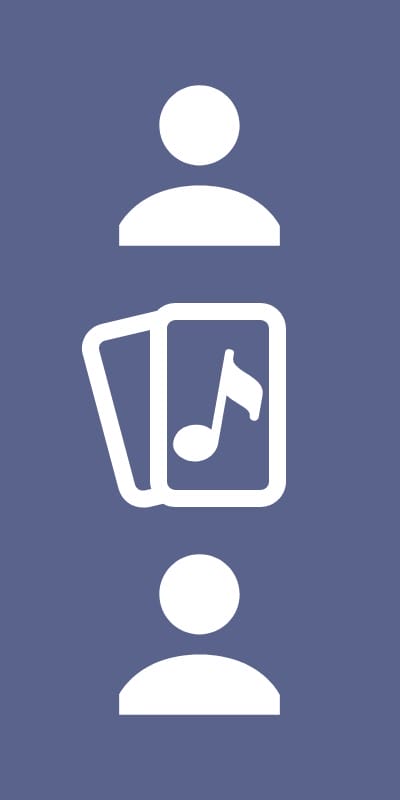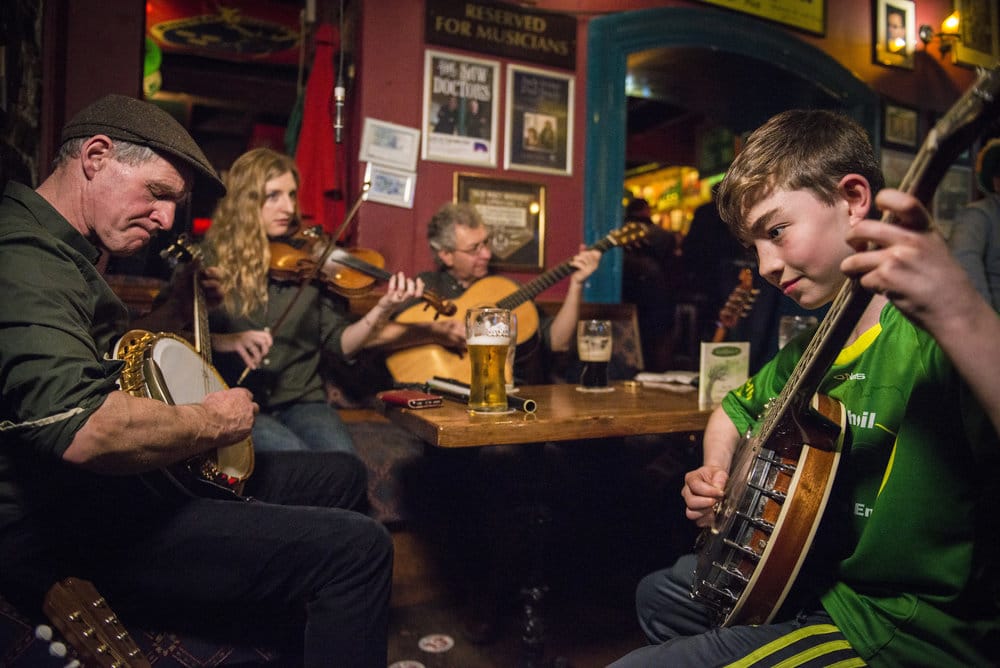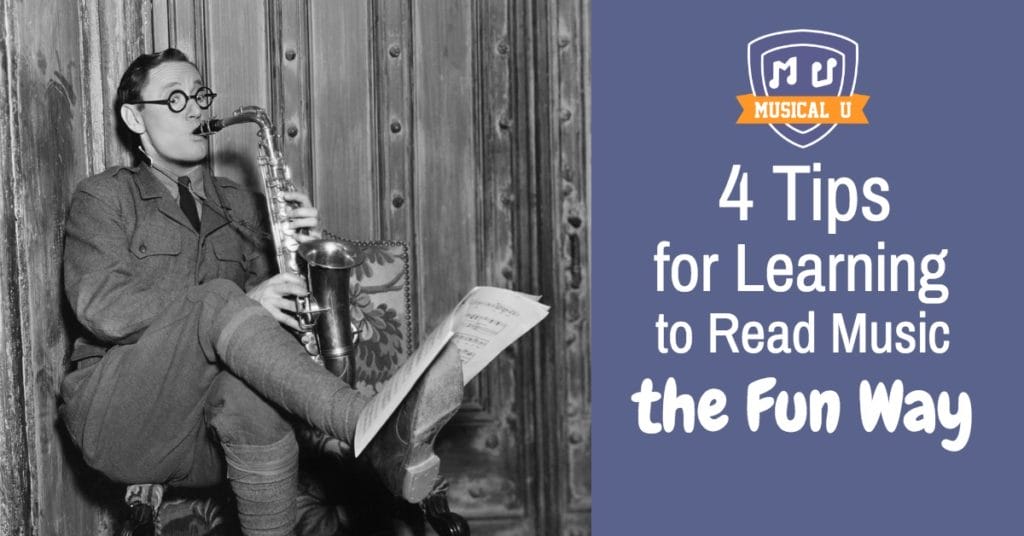Few subjects in music have the same ominous portent as the phrase “reading music”. Sadly, there are many of us who have nothing but bad memories on the subject, like a spectacle-wearing piano teacher forcing us to memorize the mnemonic “every good boy does fine”. Or being in high school band and having to sight-read awful marches from pages stained with the tears of former members.
And to be truthful, there is an unfortunate caste system separating those who can read music, and those who can’t. The music-readers often look down their noses at those who don’t read music, and the non-readers sometimes feel inferior. Or in many cases, non-readers actually feel that they are more authentically musical by the very fact that they play without sheet music. There is an old joke where a jazz musician is asked if he can read music, and he replies “not enough to hurt my playing!”.
The truth is, you can be a great musician whether or not you read music. And if you don’t, we encourage you to continue having a great time creating music by ear! However, if you’re this far into this article, the odds are that you are someone who does indeed wish to learn.
Chances are, then, that you’ve had the impression that learning to read music is an arduous process that can take years. Well, we have some good news for you: it isn’t!
Here’s the deal…if you approach it in the right way, using clever strategies and keeping the process fun, you can be reading music inside of a week. Ready to start? Let’s do this!
1. Use the Buddy System
OK, the first rule is never learn alone! Sure, it’s possible, but trust us: when you share the learning process with a friend, everything goes faster and you’ll get a lot more enjoyment out of it.

Looking at the music itself, most of the songs you’ll be “sight-reading” have chords that go with them. In other words, 80% of songs in western culture are comprised of two things: a melody and a chord progression.
When you are sight reading per se, you are reading the melody part, but the melody by itself can get a bit boring after a while. Now, if you try sight reading the melody while your friend strums the chords, you’ll have a whole new experience… suddenly you’re not just practicing, you’re jamming!
This is why we at JamAlong recommend traditional Irish tunes as one of the best ways to get better at sight reading – they all come with cool chord progressions that your Study Buddy can accompany you with. And lastly, when you have a steady strummer next to you, it forces you to stay in time, and not “cheat” by pausing to figure out the next note.
Some Musical Games
Now that you’ve got your Study Buddy lined up and ready to go, let’s talk about some of the ways you two can learn to read music together.
 Here’s what you’ll need:
Here’s what you’ll need:
- A set of Flash Cards to use to identify all the notes. We have a free set you can download, and you can either print out both the notes and the “answer” page separately, or print double sided on a single piece of paper so the note names are on the back of the card.
- A “Notation To Instrument” chart for your particular instrument (we have them for banjo, mandolin, guitar, and ukulele).
So get those printed out, and then let’s get started playing games! Here are a few ideas to get you started…
Say and Play – One of you has all the cards (or sheets), and calls out the letter name of a random note. You then have to find it and play it on your instrument. Score how many you get right, and then switch roles. Play as many rounds as you wish, then tally up your scores if you’re in the competitive spirit.
Musical Battle – You’ll need two full “decks” of flash cards for this one. Each player takes the top card from their stack. The players compare them to determine which note is higher, and the first to correctly do so takes both cards and adds them to the bottom of their stack. Continue until one of you runs out of cards.
Concentration – This is the same as the regular card game of the same name. Start with all the cards “music note side” down, spread out on the floor or table, then take turns turning over two cards. Whenever you find two of the same letter you get to keep them, and the trick is to remember what the cards were that you turned over before to find more pairs.
This is only a small example of the games you can come up with, so let your creativity go wild!
2. Sight read – but not with nursery rhymes
It is an unfortunate fact that many books that teach you to read music use the dullest melodies imaginable.
I mean, who wants to hear “Mary had a Little Lamb” or “Twinkle Twinkle, Little Star” again? You’ll have a lot more fun and therefore learn faster if you use more exciting material, so we’ve compiled a collection of some songs you’ll enjoy playing.
Try to guess them just by playing first, and then if you get stuck, look at the answers on page two. And as you pick through them, remember to be patient with yourself! Learning to read music is like learning another language, and you can’t expect yourself to be spouting eloquent phrases right off the bat.
3. Get involved in “jamming” styles of music
Traditional sight reading education has a penchant for classical music. To be clear, we have a great deal of respect for classical melodies and they can be quite rewarding to learn to play.
The drawback is that you won’t find a lot of jam sessions playing Bach or Mozart. If you’re going to take classical music seriously, you’ll eventually have to find yourself a string quartet or symphony to be a part of, and that’s quite an undertaking!
The good news is, there are styles of music that feature lots of written melody that aren’t classical music, and one of the most popular is Irish music.

The traditional Irish jam session features hundreds of intricate little melodies, all written out in music notation. We have had personal experience with many students who picked up a copy of an Irish tune book, and were delighted with how fun it was to practice their sight reading with tunes like “The Irish Washerwoman” or “The Maid Behind the Bar”:
Most of these Irish tune books have hundreds of songs in them, so you’ll have enough material to practice on for years to come. For example you can download some Irish tune books on our free eBooks and charts page, under the heading “Traditional Irish Tune Books”.
Now you can have an endless supply of melodies to practice your sight reading on, and you can find an Irish jam and double your practice time while having a ton of fun! Just so you know, it is common and even expected for the participants in a traditional Irish jam to bring a music stand and music books – so you won’t look out of place.
4. Composition as a sight reading tool
What – me, compose? No way.
Well the actual fact is, if you can hum, you can compose. Composing is in essence just coming up with little melodies, and anyone can do it.
Obviously most of us won’t be at the level of Mozart or Bach, but that’s not the point anyhow.
The sort of composing we’re wanting you to try is more like a musical game, where you’ll come up with combinations of notes and then use these “compositions” to help you with your sight-reading. It’s easy and fun, and you guessed it: we’ll be using our music cards!
This exercise is quite straightforward. Just shuffle your music cards, and then lay a number of them in a row, music side up. Put some longer spaces between them at random intervals (these will be where you pause, or “rest”), pick up your instrument of choice, and experience your masterpiece!
This exercise will give you infinite sight reading drills, because all you have to do is re-shuffle the order of your cards and presto, you have a composition! If you aren’t at the stage of knowing the notes on your instrument yet, you can still just “say and play” the row of notes, and you’ll get a great workout for memorizing the note names.
Note: This exercise is a bit more advanced, and requires you to have an idea of where the notes are on your given instrument. Be sure to have your “notation to instrument” handy for this one!
Playing Off the Page
Now that you have all the right approaches, let’s sum up these four ways to help you learn to read music:
- Learn note names with a Study Buddy to turn a potentially tedious exercise into a sport
- Practice sight reading with music that you enjoy or are curious about
- Learn melodies and licks from music that is well-suited for jamming – then go jam!
- Practice basic composition with our flash cards, and play the melodies you create
For more great free resources and other study materials, set up your complimentary account at JamAlong!
This method of learning to read music is about as easy as it gets, but if you feel like really spoiling yourself, you can always just book a “Live” Video Lesson with our friendly instructors here at JamAlong, and we’ll walk you through it every step. And it’s always nice to have someone there to answer questions when they pop up (and they will). Come visit us to book your live online video call!
Learning to read music should not be by-the-book and boring. Rather, it should involve the music you love and want to play – the music that you want to see come to life in your hands.








